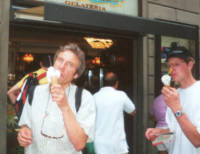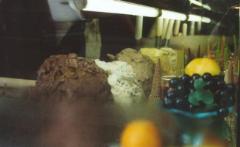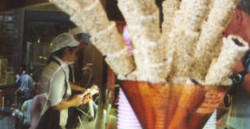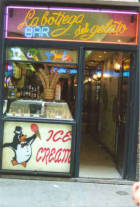|
The origins of gelato take
deep root in Sicily where only the freshest fruits, coffees and chocolates
were used in production. Today, Sicily is still world famous for its
gelato and one of the gelaterias I visited in Florence, the Gelateria
Carabe (via Ricasoli 60r) has been in business ninety-three years now
and has all its ingredients shipped in directly from Sicily. Try
their "granite limone", it is made from fresh-squeezed Sicilian
lemons and is delicious.
The ingredients of gelato
vary from region to region in Italy. Sicily makes a gelato that is
ice milk-based, while Northern Italy uses a cream-based custard for the
base ingredient. Florence, where I spent my gelato-tasting
endeavors, has a milk-and-egg yolk base for its gelato. In contrast,
American ice cream is predominately made with heavy milk and cream.
Gelato first came to Florence in the sixteenth century, under Medici
reign, and was carefully crafted to satisfy the Medici’s sweet
palate. Since then, Florence has embraced and embellished gelato,
making it world-famous.
 Set on my mission for a
first-hand experience of the "gelato phenomenon", I trekked
through several off-beat smaller streets behind the Palazzo Vecchio and came to Gelateria
dei Neri (via dei Neri 20r). I was pleasantly surprised to find
this gelateria because I had already heard raving recommendations of it
from my Italian-American friend and was curious about it. As I
stepped into the shop, I was immediately confronted by a sign reading
"Il fumo danneggia il gelato" ("smoke damages the
ice cream") and "low calorie ice cream without sugar".
This was interesting because while the first sign was written in both
Italian and English, the second was only in English, geared towards the
more weight-conscious neurotic American tourists. Set on my mission for a
first-hand experience of the "gelato phenomenon", I trekked
through several off-beat smaller streets behind the Palazzo Vecchio and came to Gelateria
dei Neri (via dei Neri 20r). I was pleasantly surprised to find
this gelateria because I had already heard raving recommendations of it
from my Italian-American friend and was curious about it. As I
stepped into the shop, I was immediately confronted by a sign reading
"Il fumo danneggia il gelato" ("smoke damages the
ice cream") and "low calorie ice cream without sugar".
This was interesting because while the first sign was written in both
Italian and English, the second was only in English, geared towards the
more weight-conscious neurotic American tourists.
 Displayed behind
shiny glass cases were about thirty-five gelato, sorbetti and semifreddo
flavors, more than any American ice cream store I’d seen. What
struck me first about the gelato, and as will be echoed and emphasized at
each other gelateria, was its presentation. It sat in large shiny
smoothly sculpted oval blocks in the freezer, and on top of each flavor
the main ingredient was artistically displayed. This helps the
gelato consumer to identify which flavor he or she is looking at if he or
she cannot understand the Italian flavor markings (though in many
gelaterias in tourist cities, the flavors are written in both Italian and
English). It also makes for a beautiful sight to look at as you
ponder the choices. At Gelateria dei Neri, the bright orange slices
carefully arranged on the mandarino gelato especially caught my
eye. Displayed behind
shiny glass cases were about thirty-five gelato, sorbetti and semifreddo
flavors, more than any American ice cream store I’d seen. What
struck me first about the gelato, and as will be echoed and emphasized at
each other gelateria, was its presentation. It sat in large shiny
smoothly sculpted oval blocks in the freezer, and on top of each flavor
the main ingredient was artistically displayed. This helps the
gelato consumer to identify which flavor he or she is looking at if he or
she cannot understand the Italian flavor markings (though in many
gelaterias in tourist cities, the flavors are written in both Italian and
English). It also makes for a beautiful sight to look at as you
ponder the choices. At Gelateria dei Neri, the bright orange slices
carefully arranged on the mandarino gelato especially caught my
eye.
 I was overwhelmed by
choices. In the United States, there are generally three choices for
a scoop size – small, medium or large (at some places, only one or two
sizes are available). In gelaterias Italy-wide, you can order
anywhere between one and eight different cup sizes. Cones usually
come in two or three sizes, and many places offer the specialty cone with
chocolate and peanuts already on it. Once you’ve conquered the
task of deciding what size you’d like, you have a wide array of gelato
flavors to pack into the cup. You can create a combination of three
to four flavors if you wish. Prices range from 2,000 lire (about
$1.00) to 8,000 lire (about $4.00). I was overwhelmed by
choices. In the United States, there are generally three choices for
a scoop size – small, medium or large (at some places, only one or two
sizes are available). In gelaterias Italy-wide, you can order
anywhere between one and eight different cup sizes. Cones usually
come in two or three sizes, and many places offer the specialty cone with
chocolate and peanuts already on it. Once you’ve conquered the
task of deciding what size you’d like, you have a wide array of gelato
flavors to pack into the cup. You can create a combination of three
to four flavors if you wish. Prices range from 2,000 lire (about
$1.00) to 8,000 lire (about $4.00).
 Since gelato is
substantially softer than ice cream, the servers do not use ice cream
scoops; they use almost a stick-like steel tool that is slightly curved at
the top to shape the gelato once it is in the cone or cup. Also,
since presentation is always key, they scoop from the back of the slab of
gelato first, so the customer is left with a perfect smooth view of the
gelato. As if I didn’t already have too many choices to make, I
was still presented with several different types of cookie wafers to stick
into the gelato and use as a spoon if so desired. It is typical for
gelaterias to stick a small plastic spoon into your cone of gelato, to
make for more creative ways of eating gelato. There were little
chocolate wafers, vanilla wafers, heart-shaped, tube-shaped. They
were only 300 or 400 lire, which is about $0.15 and are a delicious little
addition to your gelato. Since gelato is
substantially softer than ice cream, the servers do not use ice cream
scoops; they use almost a stick-like steel tool that is slightly curved at
the top to shape the gelato once it is in the cone or cup. Also,
since presentation is always key, they scoop from the back of the slab of
gelato first, so the customer is left with a perfect smooth view of the
gelato. As if I didn’t already have too many choices to make, I
was still presented with several different types of cookie wafers to stick
into the gelato and use as a spoon if so desired. It is typical for
gelaterias to stick a small plastic spoon into your cone of gelato, to
make for more creative ways of eating gelato. There were little
chocolate wafers, vanilla wafers, heart-shaped, tube-shaped. They
were only 300 or 400 lire, which is about $0.15 and are a delicious little
addition to your gelato.
I opted to just taste a few flavors at this
gelateria. If you ever go to Gelateria dei Neri, I enthusiastically
recommend their "cioccolato bianco" (white chocolate
studded with bits of dark chocolate), and their pesca (peach),
which was uncommonly smooth and fresh. As I left the colorful little
shop, I noticed another sign reading "Comitato Toscano Gelatieri –
produzione propria", announcing proudly that the gelato was
home-made, as all the best gelato is.
|



